Foliar Calcium Absorption by Tomato Plants: Comparing the Effects of Calcium Sources and Adjuvant Usage
Abstract
1. Introduction
2. Results
2.1. Characterization of Ca:Sr Sources by ICP-OES
2.2. Characterization of Ca:Sr- Citrate by FTIR
2.3. Monitoring the Foliar Absorption of Ca:Sr Sources by µ-XRF
2.4. Ultrastructural Characterization of Sr:Ca Sources on Tomato Leaves by SEM
3. Discussion
4. Material and Methods
4.1. Synthesis of Ca:Sr Sources and Preparation of Foliar Solutions
4.2. Characterization of Ca:Sr Sources
4.3. Plant Cultivation
4.4. In Vivo XRF Evaluation Foliar Absorption
4.5. Scanning Electron Mycroscropy
4.6. Statistical Analyses
5. Conclusions
Supplementary Materials
Author Contributions
Funding
Data Availability Statement
Acknowledgments
Conflicts of Interest
References
- White, P.J.; Broadley, M.R. Calcium in Plants. Ann. Bot. 2003, 92, 487–511. [Google Scholar] [CrossRef] [PubMed]
- Marschner, P. Marschner’s Mineral Nutrition of Higher Plants, 3rd ed.; Academic press: Cambridge, MA, USA, 2011; ISBN 9780123849052. [Google Scholar]
- Brini, M.; Carafoli, E. The Plasma Membrane Ca2+ ATPase and the Plasma Membrane Sodium Calcium Exchanger Cooperate in the Regulation of Cell Calcium. Cold Spring Harb. Perspect. Biol. 2011, 3, a004168. [Google Scholar] [CrossRef] [PubMed]
- Seybold, H.; Trempel, F.; Ranf, S.; Scheel, D.; Romeis, T.; Lee, J. Ca2+ Signalling in Plant Immune Response: From Pattern Recognition Receptors to Ca2+ Decoding Mechanisms. New Phytol. 2014, 204, 782–790. [Google Scholar] [CrossRef] [PubMed]
- de Freitas, S.T.; do Amarante, C.V.T.; Mitcham, E.J. Calcium Deficiency Disorders in Plants. In Postharvest Ripening Physiology of Crops; CRC Press: Boca Raton, FL, USA, 2016; ISBN 9781498703819. [Google Scholar]
- Lecourieux, D.; Mazars, C.; Pauly, N.; Ranjeva, R.; Pugin, A. Analysis and Effects of Cytosolic Free Calcium Increases in Response to Elicitors in Nicotiana Plumbaginifolia Cells. Plant Cell 2002, 14, 2627–2641. [Google Scholar] [CrossRef] [PubMed]
- Carafoli, E. Calcium—A Universal Carrier of Biological Signals. FEBS J. 2005, 272, 1073–1089. [Google Scholar] [CrossRef] [PubMed]
- Harholt, J.; Suttangkakul, A.; Vibe Scheller, H. Biosynthesis of Pectin. Plant Physiol. 2010, 153, 384–395. [Google Scholar] [CrossRef] [PubMed]
- Hill, J. The Remobilization of Nutrients from Leaves. J. Plant Nutr. 1980, 2, 407–444. [Google Scholar] [CrossRef]
- Fischer, A.M. Nutrient Remobilization during Leaf Senescence. Annu. Plant Rev. Online 2018, 26, 87–107. [Google Scholar]
- DEMARTY, M.; MORVAN, C.; THELLIER, M. Calcium and the Cell Wall. Plant. Cell Environ. 1984, 7, 441–448. [Google Scholar] [CrossRef]
- Hocking, B.; Tyerman, S.D.; Burton, R.A.; Gilliham, M. Fruit Calcium: Transport and Physiology. Front. Plant Sci. 2016, 7, 569. [Google Scholar] [CrossRef]
- Nissen, R.; Bound, S.; Adhikari, R.; Cover, I. Factors Affecting Postharvest Management of Apples: A Guide to Optimising Quality; National Library of Australia: Canberra, Australia, 2018. [Google Scholar]
- Simon, E.W. The Symptoms of Calcium Deficiency in Plants. New Phytol. 1978, 80, 1–15. [Google Scholar] [CrossRef]
- Lemoine, R.; La Camera, S.; Atanassova, R.; Dédaldéchamp, F.; Allario, T.; Pourtau, N.; Bonnemain, J.-L.; Laloi, M.; Coutos-Thévenot, P.; Maurousset, L.; et al. Source-to-Sink Transport of Sugar and Regulation by Environmental Factors. Front. Plant Sci. 2013, 4, 272. [Google Scholar] [CrossRef] [PubMed]
- Comtet, J.; Turgeon, R.; Stroock, A.D. Phloem Loading through Plasmodesmata: A Biophysical Analysis. Plant Physiol. 2017, 175, 904–915. [Google Scholar] [CrossRef] [PubMed]
- Comtet, J.; Jensen, K.H.; Turgeon, R.; Stroock, A.D.; Hosoi, A.E. Passive Phloem Loading and Long-Distance Transport in a Synthetic Tree-on-a-Chip. Nat. Plants 2017, 3, 17032. [Google Scholar] [CrossRef] [PubMed]
- Taiz, L.; Zeiger, E. Fisiologia Vegetal, 5th ed.; Artmed: Porto Alegre, Brazil, 2013; ISBN 9788536327952. [Google Scholar]
- de Assunção, H.H.T.; Campos, S.F.B.; Sousa, L.A.; Lemes, E.M.; Zandonadi, C.H.S.; da Cunha, J.P.A.R. Adjuvants plus Phytosanitary Products and the Effects on the Physical-Chemical Properties of the Spray Liquids. Biosci. J. 2019, 35, 1878–1885. [Google Scholar] [CrossRef]
- Karimi, R.; Saberi, A.; Khadivi, A. Effects of Foliar Spray of Agricultural Grade Mineral Oil in Springtime, in Combination with Potassium and Calcium Sulfates on the Phenological and Biophysical Indices of Clusters, and Foliar Nutritional Levels in Grapevine (Vitis vinifera L.) Cv. Sultana. Biol. Res. 2021, 54, 28. [Google Scholar] [CrossRef]
- Baliota, G.V.; Athanassiou, C.G. Use of Paraffin Oils in Agriculture and beyond: Back to the Future. Environ. Sci. Pollut. Res. 2023, 30, 2392–2405. [Google Scholar] [CrossRef]
- Helmy, E.I.; Kwaiz, F.A.; El-Sahn, O.M.N. The Usage of Mineral Oils to Control Insects. Egypt. Acad. J. Biol. Sci. A Entomol. 2012, 5, 167–174. [Google Scholar] [CrossRef]
- Damavandian, M.R. Laboratory and Field Evaluation of Mineral Oil Spray for the Control of Citrus Red Mite, Panonychus Citri (McGregor). Acta Agric. Scand. Sect. B—Plant Soil Sci. 2007, 57, 92–96. [Google Scholar] [CrossRef]
- Chalermnon, M.; Cherdchom, S.; Sereemaspun, A.; Rojanathanes, R.; Khotavivattana, T. Biguanide-Based Synthesis of 1,3,5-Triazine Derivatives with Anticancer Activity and 1,3,5-Triazine Incorporated Calcium Citrate Nanoparticles. Molecules 2021, 26, 1028. [Google Scholar] [CrossRef]
- Li, J.; Liu, Y.; Gao, Y.; Zhong, L.; Zou, Q.; Lai, X. Preparation and Properties of Calcium Citrate Nanosheets for Bone Graft Substitute. Bioengineered 2016, 7, 376–381. [Google Scholar] [CrossRef] [PubMed]
- Haynes, W.M. CRC Handbook of Chemistry and Physics; CRC Press: Boca Raton, FL, USA, 2014; ISBN 1482208687. [Google Scholar]
- Russell, R.S.; Squire, H.M. The Absorption and Distribution of Strontium in Plants: I. Preliminary Studies in Water Culture. J. Exp. Bot. 1958, 9, 262–276. [Google Scholar]
- Rediske, J.H.; Selders, A.A. The Absorption and Translocation of Strontium by Plants. Plant Physiol. 1953, 28, 594. [Google Scholar] [PubMed]
- Walsh, T. The Effect on Plant Growth of Substituting Strontium for Calcium in Acid Soils. Proc. R. Ir. Acad. Sect. B Biol. Geol. Chem. Sci. JSTOR 1944, 50, 287–294. [Google Scholar]
- Burger, A.; Lichtscheidl, I. Strontium in the Environment: Review about Reactions of Plants towards Stable and Radioactive Strontium Isotopes. Sci. Total Environ. 2019, 653, 1458–1512. [Google Scholar]
- Jovanović, P.; Rachmilevitch, S.; Roitman, N.; Erel, R. Strontium as a Tracer for Calcium: Uptake, Transport and Partitioning within Tomato Plants. Plant Soil 2021, 466, 303–316. [Google Scholar] [CrossRef]
- Storey, R.; Leigh, R.A. Processes Modulating Calcium Distribution in Citrus Leaves. An Investigation Using X-ray Microanalysis with Strontium as a Tracer. Plant Physiol. 2004, 136, 3838–3848. [Google Scholar] [CrossRef] [PubMed]
- Rosen, C.J.; Bierman, P.M.; Telias, A.; Hoover, E.E. Foliar- and Fruit-Applied Strontium as a Tracer for Calcium Transport in Apple Trees. HortScience 2006, 41, 220–224. [Google Scholar] [CrossRef]
- Moyen, C.; Roblin, G. Uptake and Translocation of Strontium in Hydroponically Grown Maize Plants, and Subsequent Effects on Tissue Ion Content, Growth and Chlorophyll a/b Ratio: Comparison with Ca Effects. Environ. Exp. Bot. 2010, 68, 247–257. [Google Scholar] [CrossRef]
- Fernández, V.; Sotiropoulos, T.; Brown, P. Adubação Foliar; ABISOLO: São Paulo, Brazil, 2015; ISBN 9788569084006. [Google Scholar]
- Gomes, M.H.F.; Machado, B.A.; Rodrigues, E.S.; Montanha, G.S.; Rossi, L.; Otto, R.; Linhares, F.S.; Carvalho, H.W.P. In Vivo Evaluation of Zn Foliar Uptake and Transport in Soybean Using X-ray Absorption and Fluorescence Spectroscopy. J. Agric. Food Chem. 2019, 67, 12172–12181. [Google Scholar] [CrossRef]
- Lötze, E.; Theron, K.I. Dynamics of Calcium Uptake with Pre-Harvest Sprays to Reduce Bitter Pit in ‘Golden Delicious’. Acta Hortic. 2006, 721, 313–320. [Google Scholar] [CrossRef]
- Galeriani, T.M.; Neves, G.O.; Santos Ferreira, J.H.; Oliveira, R.N.; Oliveira, S.L.; Calonego, J.C.; Crusciol, C.A.C. Calcium and Boron Fertilization Improves Soybean Photosynthetic Efficiency and Grain Yield. Plants 2022, 11, 2937. [Google Scholar] [CrossRef] [PubMed]
- Val, J.; Fernández, V. In-season Calcium-spray Formulations Improve Calcium Balance and Fruit Quality Traits of Peach. J. Plant Nutr. Soil Sci. 2011, 174, 465–472. [Google Scholar] [CrossRef]
- El-Razek, E.; Amin, O.; El-Nahrawy, A.; Abdel-Hamid, N. Effect of Foliar Application of Biosimulated Nanomaterials (Calcium/Yeast Nanocomposite) on Yield and Fruit Quality of “Ewais” Mango Trees. Annu. Res. Rev. Biol. 2017, 18, 1–11. [Google Scholar] [CrossRef]
- Farooq, A.; Javad, S.; Jabeen, K.; Ali Shah, A.; Ahmad, A.; Noor Shah, A.; Nasser Alyemeni, M.; Mosa, W.F.; Abbas, A. Effect of Calcium Oxide, Zinc Oxide Nanoparticles and Their Combined Treatments on Growth and Yield Attributes of Solanum lycopersicum L. J. King Saud Univ.—Sci. 2023, 35, 102647. [Google Scholar] [CrossRef]
- Song, W.; Yi, J.; Kurniadinata, O.F.; Wang, H.; Huang, X. Linking Fruit Ca Uptake Capacity to Fruit Growth and Pedicel Anatomy, a Cross-Species Study. Front. Plant Sci. 2018, 9, 575. [Google Scholar] [CrossRef]
- Song, W.-P.; Chen, W.; Yi, J.-W.; Wang, H.-C.; Huang, X.-M. Ca Distribution Pattern in Litchi Fruit and Pedicel and Impact of Ca Channel Inhibitor, La3+. Front. Plant Sci. 2018, 8, 2228. [Google Scholar] [CrossRef]
- Bonomelli, C.; Fernández, V.; Martiz, J.; Videla, X.; Arias, M.I.; Rojas-Silva, X.; Nario, A. Absorption and Distribution of Root, Fruit, and Foliar-Applied 45Ca in ‘Clemenules’ Mandarin Trees. J. Sci. Food Agric. 2020, 100, 4643–4650. [Google Scholar] [CrossRef]
- Pan, H.-B.; Darvell, B.W. Calcium Phosphate Solubility: The Need for Re-Evaluation. Cryst. Growth Des. 2009, 9, 639–645. [Google Scholar] [CrossRef]
- Vavrusova, M.; Skibsted, L.H. Aqueous Solubility of Calcium Citrate and Interconversion between the Tetrahydrate and the Hexahydrate as a Balance between Endothermic Dissolution and Exothermic Complex Formation. Int. Dairy J. 2016, 57, 20–28. [Google Scholar] [CrossRef]
- Schonherr, J. Characterization of Aqueous Pores in Plant Cuticles and Permeation of Ionic Solutes. J. Exp. Bot. 2006, 57, 2471–2491. [Google Scholar] [CrossRef] [PubMed]
- Rodrigues, E.S.; Montanha, G.S.; Gomes, M.H.F.; Duran, N.M.; Corrêa, C.G.; Romeu, S.L.Z.; Pereira, A.E.S.; de Oliveira, J.L.; de Almeida, E.; Pérez-de-Luque, A.; et al. Are Nanomaterials Leading to More Efficient Agriculture? Outputs from 2009–2022 Research Metadata Analysis. agriRxiv 2021, 2021, 20210198122. [Google Scholar] [CrossRef]
- Martin, L.B.B.; Romero, P.; Fich, E.A.; Domozych, D.S.; Rose, J.K.C. Cuticle Biosynthesis in Tomato Leaves Is Developmentally Regulated by Abscisic Acid. Plant Physiol. 2017, 174, 1384–1398. [Google Scholar] [CrossRef] [PubMed]
- Gomes, M.H.F.; de Almeida Machado, B.; Marques, J.P.R.; Otto, R.; Eichert, T.; Pereira de Carvalho, H.W. Foliar Application of Zn Phosphite and Zn EDTA in Soybean (Glycine max (L.) Merrill): In Vivo Investigations of Transport, Chemical Speciation, and Leaf Surface Changes. J. Soil Sci. Plant Nutr. 2020, 20, 2731–2739. [Google Scholar] [CrossRef]
- Machado, B.A.; Gomes, M.H.F.; Marques, J.P.R.; Otto, R.; De Carvalho, H.W.P. X-ray Spectroscopy Fostering the Understanding of Foliar Uptake and Transport of Mn by Soybean (Glycine Max L. Merril): Kinetics, Chemical Speciation, and Effects of Glyphosate. J. Agric. Food Chem. 2019, 67, 13010–13020. [Google Scholar] [CrossRef] [PubMed]
- Schönherr, J. Calcium Chloride Penetrates Plant Cuticles via Aqueous Pores. Planta 2000, 212, 112–118. [Google Scholar] [CrossRef] [PubMed]
- Corrêa, C.G.; Rebouças, M.T.; Diniz, M.; Pereira de Carvalho, H.W. Effect of Counterions on the Foliar Absorption and Transport of Potassium in Soybeans [Glycine max (L.) Merrill]. ACS Agric. Sci. Technol. 2021, 1, 728–734. [Google Scholar] [CrossRef]
- Kalcsits, L.; van der Heijden, G.; Reid, M.; Mullin, K. Calcium Absorption during Fruit Development in ‘Honeycrisp’ Apple Measured Using 44Ca as a Stable Isotope Tracer. HortScience 2017, 52, 1804–1809. [Google Scholar] [CrossRef]
- Wilsdorf, R.E.; Theron, K.I.; LöTZE, E. Evaluating the Effectiveness of Different Strategies for Calcium Application on the Accumulation of Calcium in Apple (Malus × domestica Borkh. ‘Braeburn’) Fruit. J. Hortic. Sci. Biotechnol. 2012, 87, 565–570. [Google Scholar] [CrossRef]
- Montanha, G.S.; Marques, J.P.R.; Santos, E.; Jones, M.W.M.; de Carvalho, H.W.P. Physiological Responses of Plants to in Vivo X-ray Damage from X-ray Fluorescence Measurements: Insights from Anatomical, Elemental, Histochemical, and Ultrastructural Analyses. Metallomics 2023, 15, mfad034. [Google Scholar] [CrossRef]
- BOWEN, H.J.M.; DYMOND, J.A. The Uptake of Calcium and Strontium by Plants from Soils and Nutrient Solutions. J. Exp. Bot. 1956, 7, 264–272. [Google Scholar] [CrossRef]
- Ramírez-Rodríguez, G.B.; Dal Sasso, G.; Carmona, F.J.; Miguel-Rojas, C.; Pérez-de-Luque, A.; Masciocchi, N.; Guagliardi, A.; Delgado-López, J.M. Engineering Biomimetic Calcium Phosphate Nanoparticles: A Green Synthesis of Slow-Release Multinutrient (NPK) Nanofertilizers. ACS Appl. Bio Mater. 2020, 3, 1344–1353. [Google Scholar] [CrossRef] [PubMed]
- Rodrigues, E.S.; Montanha, G.S.; Marques, J.P.R.; de Almeida, E.; Yabuki, L.N.M.; Menegário, A.A.; Pereira de Carvalho, H.W. Foliar Application of Rare Earth Elements on Soybean (Glycine max (L)): Effects on Biometrics and Characterization of Phytotoxicity. J. Rare Earths 2020, 38, 1131–1139. [Google Scholar] [CrossRef]
- Rodrigues, E.S.; Gomes, M.H.F.; Duran, N.M.; Cassanji, J.G.B.; da Cruz, T.N.M.; Sant’Anna Neto, A.; Savassa, S.M.; de Almeida, E.; Carvalho, H.W.P. Laboratory Microprobe X-ray Fluorescence in Plant Science: Emerging Applications and Case Studies. Front. Plant Sci. 2018, 9, 1588. [Google Scholar] [CrossRef] [PubMed]
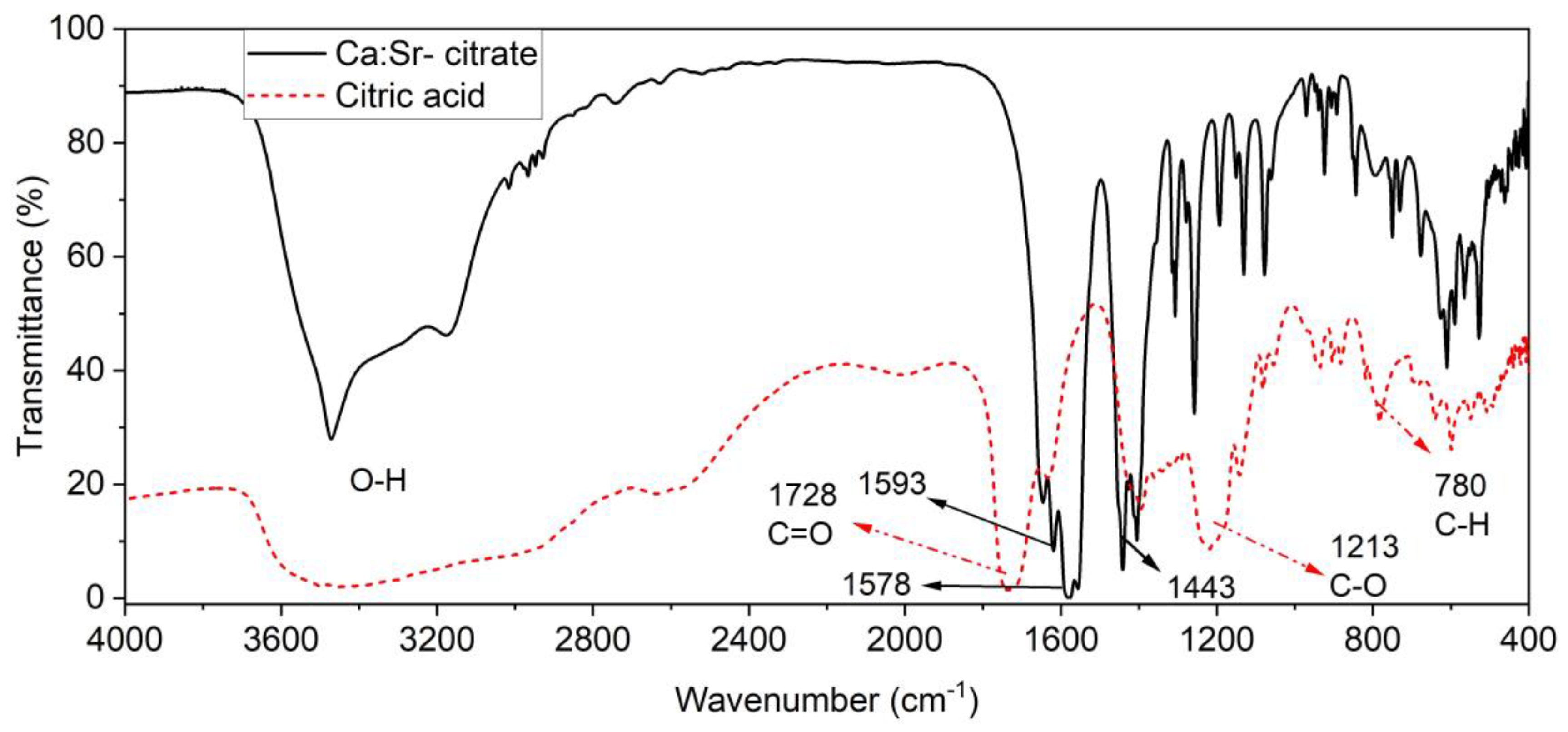

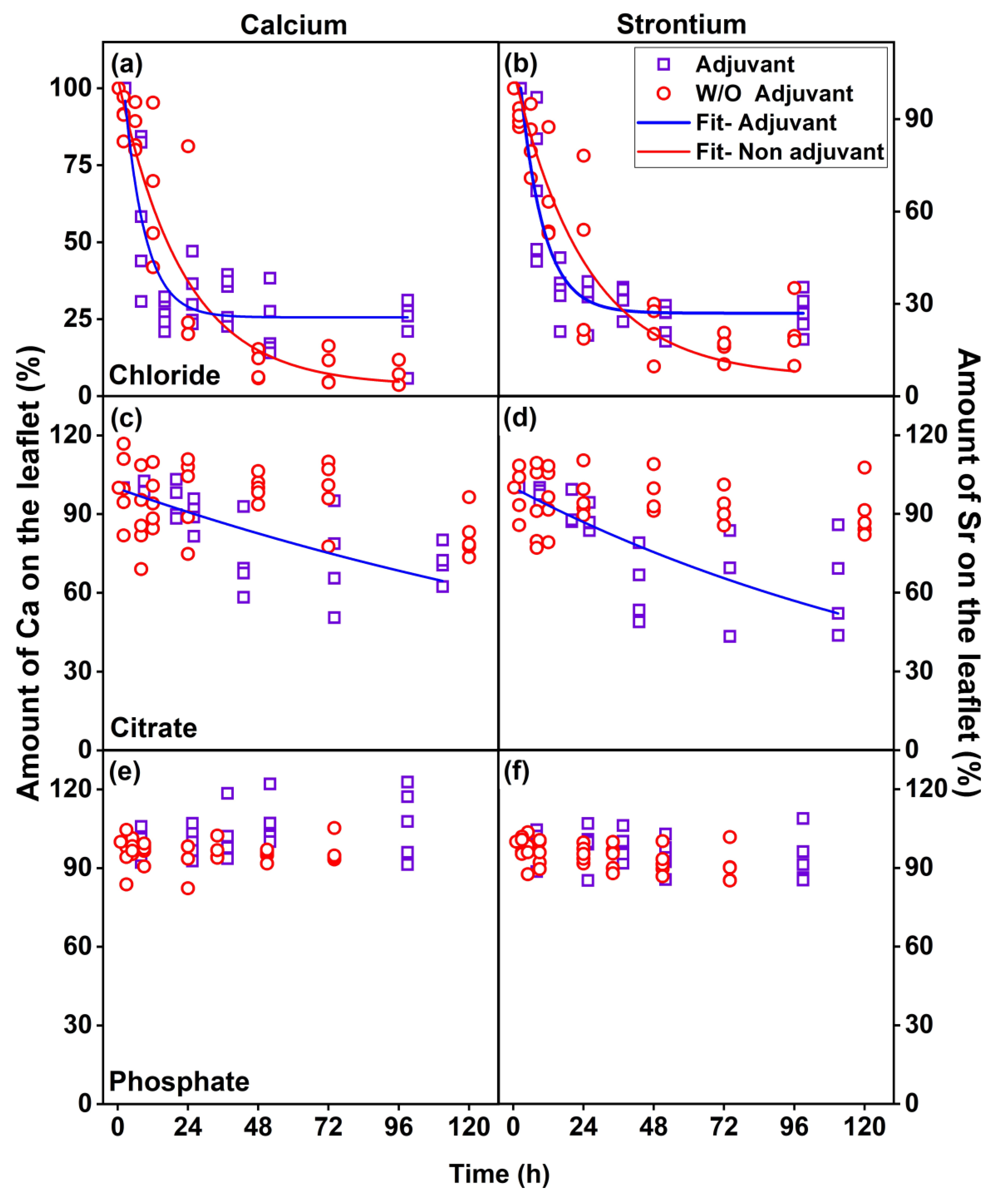
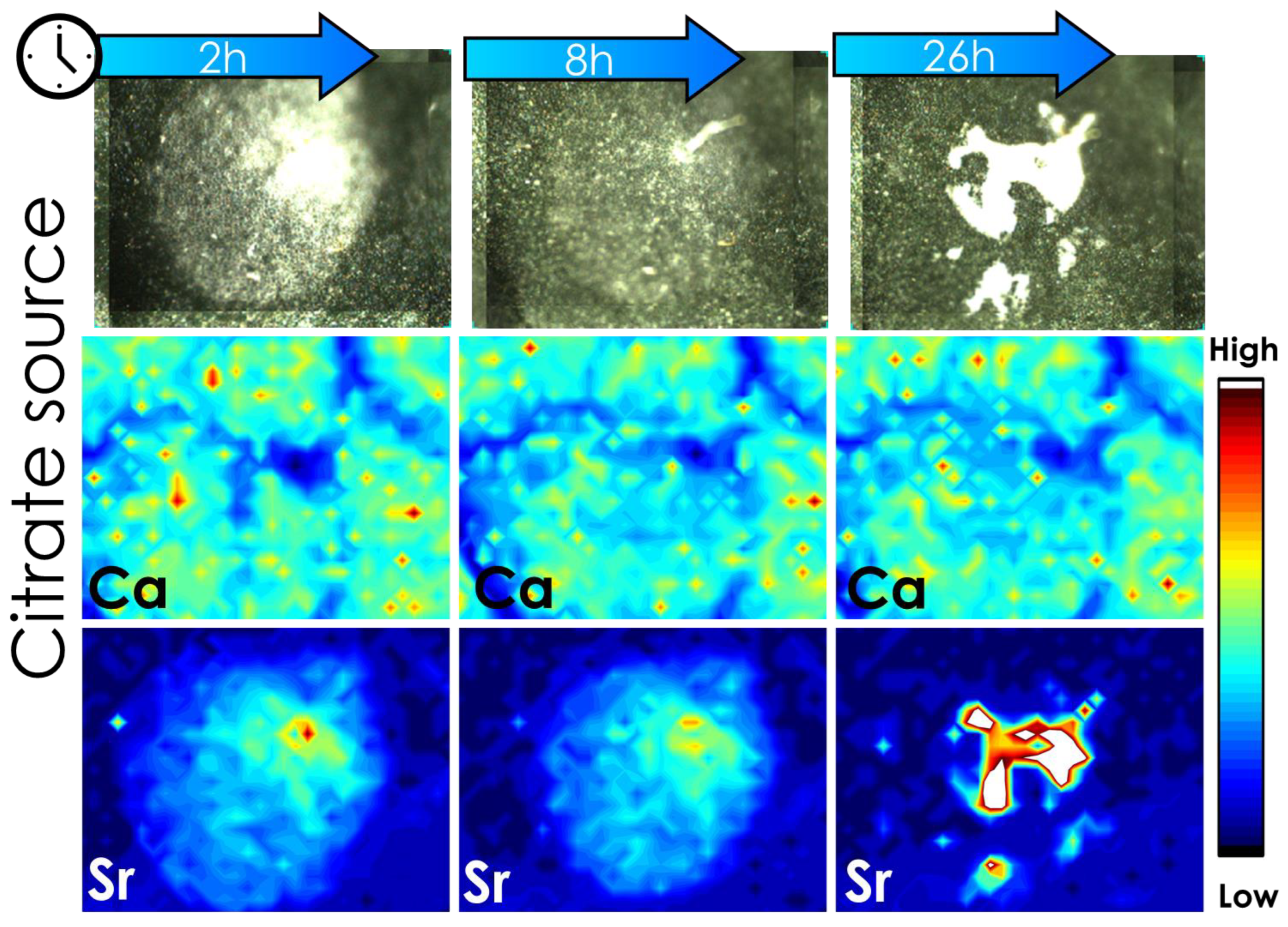
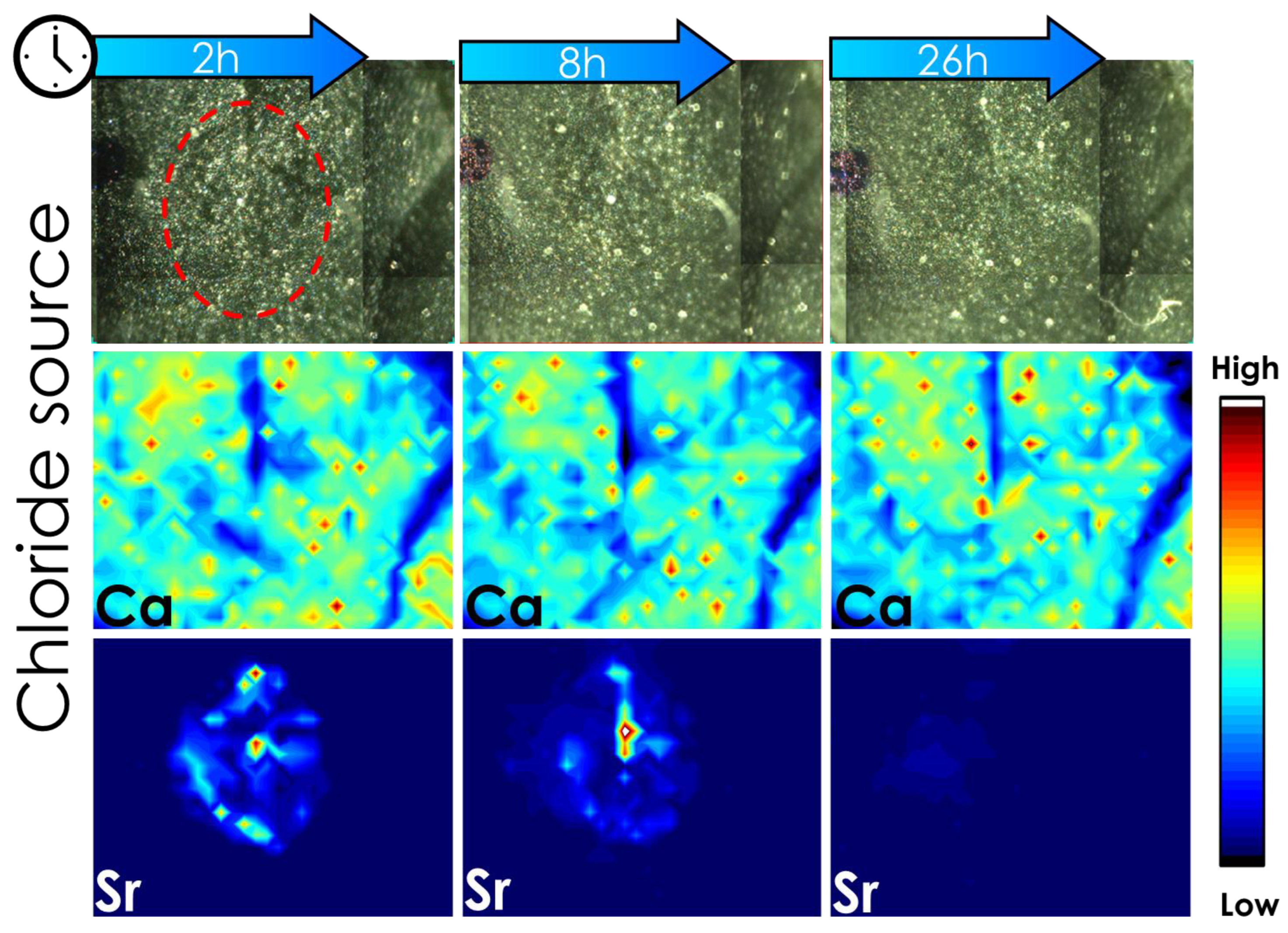
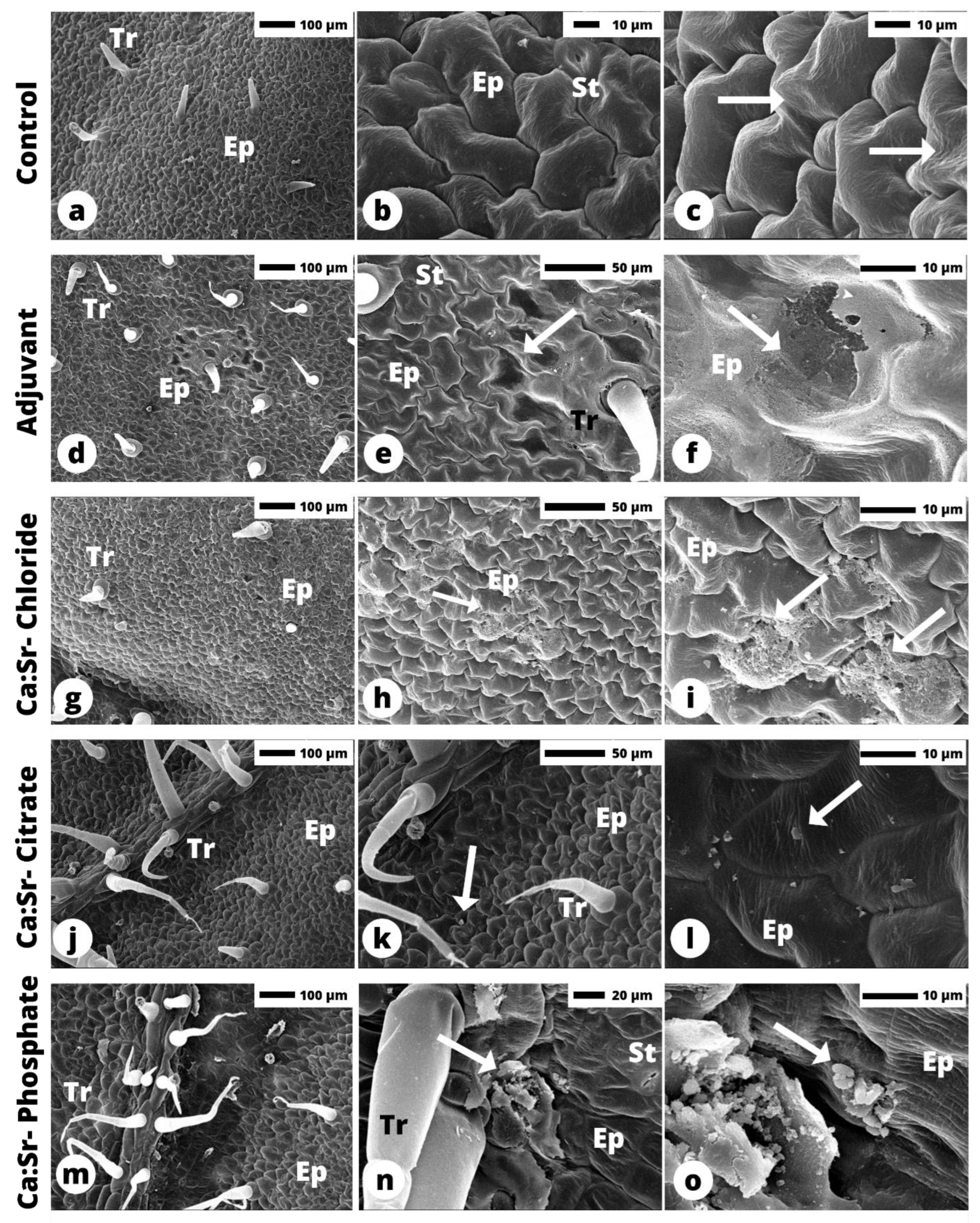
| Compound | Ca | Sr | Ca:Sr |
|---|---|---|---|
| (mol kg−1) | |||
| Ca:Sr- citrate | 3.4 ± 0.03 | 0.540 ± 0.2 | 6.23 |
| Ca:Sr- chloride | 0.1 ± 0.001 | 0.014 ± 0.0 | 7.29 |
| Ca:Sr- phosphate | 0.4 ± 0.197 | 0.073 ± 0.3 | 5.46 |
| Calcium | ||||||
|---|---|---|---|---|---|---|
| Treatment | y0 (%) | A1 (%) | R2 | Abs. Rate (h−1) | t50% (h) | Abs.F (%) |
| Chloride + adjuvant | 25.6 ± 2.9 | 100 | 0.8 | 0.14 | 4.9 | 74.4 |
| Chloride − adjuvant | 3.3 ± 4.6 | 100 | 0.9 | 0.045 | 15.4 | 96.7 |
| Strontium | ||||||
| Chloride + adjuvant | 27.0 ± 2.6 | 100 | 0.9 | 0.13 | 5.5 | 73 |
| Chloride − adjuvant | 6.1 ± 4.3 | 100 | 0.9 | 0.041 | 17 | 93.9 |
| Time (Hour) | Sr Chloride + Adjuvant (%) | Sr Citrate + Adjuvant (%) |
|---|---|---|
| 2 | 100 | 100 |
| 6 | 92.1 ± 2.3 | 83.4 ± 7.8 |
| 26 | * 37.8 ± 7.2 | 77.7 ± 7.6 |
Disclaimer/Publisher’s Note: The statements, opinions and data contained in all publications are solely those of the individual author(s) and contributor(s) and not of MDPI and/or the editor(s). MDPI and/or the editor(s) disclaim responsibility for any injury to people or property resulting from any ideas, methods, instructions or products referred to in the content. |
© 2023 by the authors. Licensee MDPI, Basel, Switzerland. This article is an open access article distributed under the terms and conditions of the Creative Commons Attribution (CC BY) license (https://creativecommons.org/licenses/by/4.0/).
Share and Cite
Santos, E.; Montanha, G.S.; Agostinho, L.F.; Polezi, S.; Marques, J.P.R.; de Carvalho, H.W.P. Foliar Calcium Absorption by Tomato Plants: Comparing the Effects of Calcium Sources and Adjuvant Usage. Plants 2023, 12, 2587. https://doi.org/10.3390/plants12142587
Santos E, Montanha GS, Agostinho LF, Polezi S, Marques JPR, de Carvalho HWP. Foliar Calcium Absorption by Tomato Plants: Comparing the Effects of Calcium Sources and Adjuvant Usage. Plants. 2023; 12(14):2587. https://doi.org/10.3390/plants12142587
Chicago/Turabian StyleSantos, Eduardo, Gabriel Sgarbiero Montanha, Luís Fernando Agostinho, Samira Polezi, João Paulo Rodrigues Marques, and Hudson Wallace Pereira de Carvalho. 2023. "Foliar Calcium Absorption by Tomato Plants: Comparing the Effects of Calcium Sources and Adjuvant Usage" Plants 12, no. 14: 2587. https://doi.org/10.3390/plants12142587
APA StyleSantos, E., Montanha, G. S., Agostinho, L. F., Polezi, S., Marques, J. P. R., & de Carvalho, H. W. P. (2023). Foliar Calcium Absorption by Tomato Plants: Comparing the Effects of Calcium Sources and Adjuvant Usage. Plants, 12(14), 2587. https://doi.org/10.3390/plants12142587






